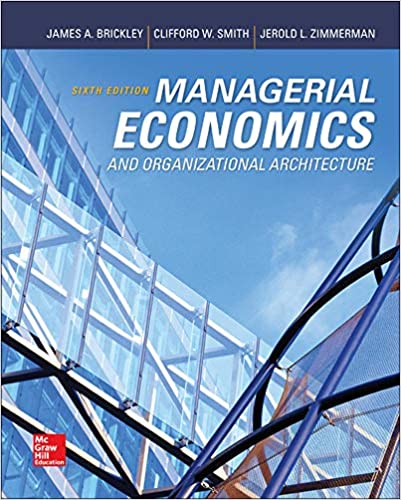
Managerial Economics & Organizational Architecture 6th Edition by James Brickley , Clifford Smith ,Jerold Zimmerman
Edition 6ISBN: 978-0073523149
Managerial Economics & Organizational Architecture 6th Edition by James Brickley , Clifford Smith ,Jerold Zimmerman
Edition 6ISBN: 978-0073523149 Exercise 12
Bill and Chris produce balls and bats. In one hour. Bill can produce two bats or four balls, while Chris can produce one bat or three balls. They each work 10 hours a day.
a. Which of the following, if any, is true Explain why.
1. Chris has an absolute advantage producing balls and a comparative advantage producing balls.
2. Chris has an absolute advantage producing balls and Bill has a comparative advantage producing balls.
3. Bill has an absolute advantage producing balls and a comparative advantage producing balls.
4. Bill has an absolute advantage producing balls and Chris has a comparative advantage producing balls.
b. If Chris and Bill each split their time evenly between producing balls and producing bats, what is the total number of bats and balls that will be produced in one day
c. Can the combined production of balls be increased while holding the number of bats produced constant How
d. Graph the combined production possibilities frontier for Bill and Chris. Place Bats on the vertical axis and Balls on the horizontal axis. [The graph would show the maximum combined amount of bats that could be produced by Bill and Chris for each feasible combined amount of balls that could be produced.]
a. Which of the following, if any, is true Explain why.
1. Chris has an absolute advantage producing balls and a comparative advantage producing balls.
2. Chris has an absolute advantage producing balls and Bill has a comparative advantage producing balls.
3. Bill has an absolute advantage producing balls and a comparative advantage producing balls.
4. Bill has an absolute advantage producing balls and Chris has a comparative advantage producing balls.
b. If Chris and Bill each split their time evenly between producing balls and producing bats, what is the total number of bats and balls that will be produced in one day
c. Can the combined production of balls be increased while holding the number of bats produced constant How
d. Graph the combined production possibilities frontier for Bill and Chris. Place Bats on the vertical axis and Balls on the horizontal axis. [The graph would show the maximum combined amount of bats that could be produced by Bill and Chris for each feasible combined amount of balls that could be produced.]
Explanation
In the question it is given that Bill an...
Managerial Economics & Organizational Architecture 6th Edition by James Brickley , Clifford Smith ,Jerold Zimmerman
Why don’t you like this exercise?
Other Minimum 8 character and maximum 255 character
Character 255


